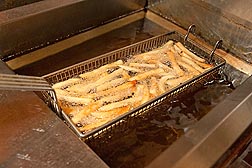|
|
|
|
New Process Quickly Analyzes Acrylamide in French Fries
By Sandra Avant
November 30, 2016
A technique called “near-infrared spectroscopy” (NIRS) can rapidly estimate the amount of acrylamide in white-potato French fries, according to a study by U.S. Department of Agriculture (USDA) scientists and their North Carolina State University collaborators.
Acrylamide is a potentially toxic compound that forms in potatoes and other foods when they are fried, roasted or baked at high temperatures. The Food and Drug Administration (FDA) has issued recommendations to help the food industry reduce the amount of acrylamide in certain foods. According to the FDA, certain foods are likely to contain more acrylamide than others, including potato products such as French fries. Reducing acrylamide levels in certain fried foods can help consumers reduce the potential risk associated with this toxic compound.
Scientists at the Agricultural Research Service (ARS) Food Science Research Unit (FSRU) in Raleigh, North Carolina, work to reduce acrylamide while maintaining health-promoting compounds in foods.
The current process used to determine acrylamide levels in food requires sophisticated analytical techniques that take a long time and requires expensive equipment, according to FSRU food scientist Suzanne Johanningsmeier.
In a recent study, Johanningsmeier and her colleagues used NIRS technology to detect acrylamide in potato flour spiked with different levels of the compound. They then used NIRS to test and analyze French fries produced with various pretreatments and cooking times.
From these data, a predictive model was developed to rapidly estimate acrylamide content, which is also less expensive than current methods.
Food processors typically pay about $250 per sample to test French fries and other products for acrylamide, according to FSRU research leader Van-Den Truong. The cost per sample using the new model would be about $25.
The NIRS technique also gives potato breeders and processors a quicker, less expensive method to test and evaluate large numbers of potato hybrids for potential acrylamide formation, according to Johanningsmeier.
This research was supported by a USDA-National Institute of Food and Agriculture Specialty Crop Research Initiative Grant.
Read more about this research in the November 2016 issue of AgResearch magazine.
ARS is USDA’s chief in-house scientific research agency.

